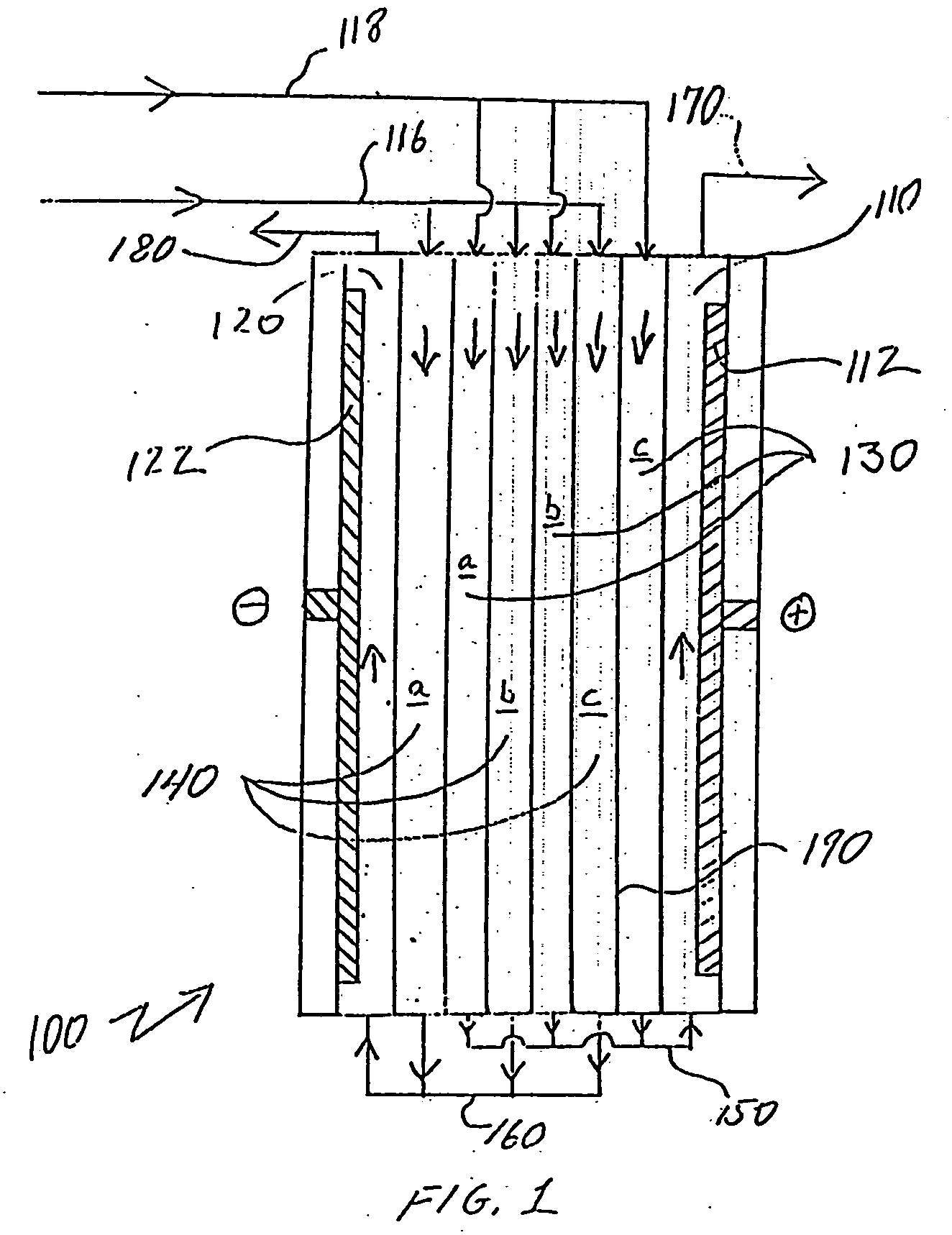Water treatment system and method
a water treatment system and water treatment technology, applied in water/sewage treatment by ion exchange, electrodialysis, refrigeration components, etc., can solve the problems that water that contains hardness species such as calcium and magnesium may be undesirable for some industrial uses, and achieve the effect of reducing the ph of the second fluid and reducing the corrosiveness of the third fluid
- Summary
- Abstract
- Description
- Claims
- Application Information
AI Technical Summary
Benefits of technology
Problems solved by technology
Method used
Image
Examples
example 1
[0052] In one experiment, the effectiveness of partially diverting the dilute stream to the cathode as electrode feed was evaluated. A 25 cell pair stack electrodeionization device was fed with a water having about 18 gpg (grains per gallon) hardness and a conductivity of about 730 μS / cm. The feed pressure was about 20 psi and the voltage was applied at about 30 volts. The total dilute flow through the ion-depleting compartments was about 1500 ml / min and a portion of this flow was provided to the cathode compartment to provide an electrode flow of about 250 ml / min. Reject flow from the ion-concentrating compartments was about 480 ml / min. The stack was operated independently of a tank system. Results from this experiment are shown in Table 1, below and in FIG. 4.
TABLE 1Hardness(gpg)Alkalinity (ppm)pHTDS (ppm)LSIDilute10.21747.36295−0.18Reject456008.061132 1.62Electrode12.22149.43222.03
[0053] The hardness rejection was about 45% and the TDS rejection was about 41%. After about a day...
example 2
[0054] In another experiment, the system shown in FIG. 3 was operated with the stack of Example 1. However, a change to the flow path through the stack was made. In this case, instead of shunting a portion of the product water to the electrode chamber, raw water was used as cathode feed fluid. A capillary was used to control the reject discharge at about 250 ml / min and a 30 second flush of the reject stream was run between cycles. About ten gallons of water was discharged from the tank every three hours resulting in about an 80 gallon draw per day. The conductivity of the tank was reduced within about 1-½ hours of startup but the electrode capillary was plugged due to scale formation. Data for various fluid streams are provided in Table 2, below.
TABLE 2Feed toDiluteRejectdiluteConc. FlushCatholyteHardness (gpg)4.5245.116.017.5Alkalinity (ppm)7033080250250pH6.977.316.157.77.7TDS (ppm)136649150459489LSI−1.30.38−2.00.50.52Conductivity200946222663715(μS / cm)
[0055] This example showed t...
example 3
[0056] In another experiment, the same system used in Example 2 above was employed with additional changes to the stack. In this case, the ion-depleting compartment chamber was plumbed directly to the cathode compartment so that all of the product water flowed through the cathode compartment. In this manner, the flow rate through the cathode was increased to about 1500 ml / min. About 52 volts were applied to the 25 cell pair stack. As shown in FIG. 5, within about two hours after about a 12 gallon discharge from the tank, the purity of the tank outlet had achieved the cutoff value of about 220 μS / cm. The left axis provides conductivity in μS / cm and the right axis provides current in amps. The percent rejection at the time the system was shut down (upon meeting the cutoff value) was about 64%. Also of note is that there was no evidence of scaling in the cathode compartment.
[0057] This demonstrates that when a large portion of the product water, for example, 100% of the product water,...
PUM
| Property | Measurement | Unit |
|---|---|---|
| Fraction | aaaaa | aaaaa |
| Fraction | aaaaa | aaaaa |
| Fraction | aaaaa | aaaaa |
Abstract
Description
Claims
Application Information
 Login to View More
Login to View More - Generate Ideas
- Intellectual Property
- Life Sciences
- Materials
- Tech Scout
- Unparalleled Data Quality
- Higher Quality Content
- 60% Fewer Hallucinations
Browse by: Latest US Patents, China's latest patents, Technical Efficacy Thesaurus, Application Domain, Technology Topic, Popular Technical Reports.
© 2025 PatSnap. All rights reserved.Legal|Privacy policy|Modern Slavery Act Transparency Statement|Sitemap|About US| Contact US: help@patsnap.com



